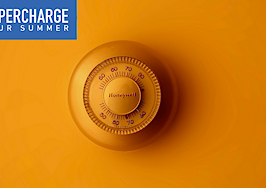This article is part of our ongoing series offering tips on how to sharped your skills this summer and use the season to your advantage. Read more in our Supercharge Your Summer section.
Between rising global temperatures, rising fuel costs and rising demand for indoor space, home energy efficiency is more important than ever before. That’s especially true in hot climates, where cooling costs can make or break the household budget.
So, what are the best things to look for in an energy efficient home in hot climates? That’s a good question. Aside from the usual variables, there are other elements to consider including new technologies, new appliances and new concepts like passive house and net zero.
To help cut through the clutter, skim over kitchen appliances and other details that can be adjusted. Zero in on fundamental features of the house and its environs. These are factors that would be expensive, complicated or downright impossible to change.
1. Roof overhangs
These went out of style in the 20th century when AC first came in. Now they’re back, and they’re proven to save on cooling costs by blocking the midday sun from windows.
2. Compact footprint and layout
The advent of AC provided hot-climate architects with the freedom to add bay windows and other interesting features, but they comes with a price. Homes that fit closely into a square or circle are more efficient.
3. Orientation: the sun
Look for relatively more window area on the north wall, where there is less exposure during the middle of the day. South-facing windows can be protected by a porch or a roof overhang. Window area on the east and west walls should be more limited, or protected by other features like a garage or shed on the property, a nearby building, or a hill or a mature tree. That’s especially true for west-facing windows, where roof overhangs don’t block the sinking sun during those long, lazy — and hot — late summer afternoons.
4. Orientation: the wind
Look for window placement that takes advantage of cross breezes for natural night-time cooling. Patios and other outdoor spaces should be located where prevailing winds help cool the space. Keep an eye out, though, for nearby buildings, forested areas, hills and other wind-blocking factors.
5. Appropriate construction
Not all types of hot-climate construction are ideal for all hot climates. For example, earth sheltered homes are highly efficient because they take advantage of natural cooling. However, the energy savings could be a wash in regions where high humidity and ample rainfall require additional systems for drainage and moisture control.
6. Appropriate landscape
Trees are proven to create a significant cooling effect when strategically planted around a home. That’s fine in regions where natural rainwater supports a thriving treescape. In arid regions, though, the expense of maintaining mature trees could cut into the savings on cooling.
David Roberts, the Residential Buildings Research Group Manager for the National Renewable Energy Laboratory in Colorado, offers a research-oriented perspective:
“…Ideally one would assess options for a specific climate, utility rates, building geometry, and energy-efficiency feature costs with a building energy modeling tool like BEopt (beopt.nrel.gov) to determine the most cost-optimal performance. The Building America Solution Center (basc.pnnl.gov/optimized-climate-solutions) also offers case studies of energy efficient homes in specific climates.”
Got all that? If not, Roberts suggests considering what kinds of energy are used in the home:
“In general, key features of an energy efficient home in hot climates depend on whether the home is served by natural gas, or uses only electricity.”
For example, a condensing, gas-fired, tankless water heater makes sense in a home served with natural gas. Without natural gas, heat pumps make more sense for water heating.
In regions where humidity is a concern, Roberts also cautions that air conditioning alone is not generally the most effective way to control moisture:
“Depending on construction details and location of the home, a supplemental, whole-house dehumidification system may be required to ensure occupant comfort and to reduce the risk of moisture problems.”
From a more hands-on perspective, the VP for Energy Efficiency and Sustainability at Meritage Homes, C.R. Herro, advises to think about the three main ways that heat works its way into a home.
Conduction:
The roof is the first line of defense for heat traveling through a solid, aka conduction. Look for good insulation in the attic, including a radiant barrier that reflects heat.
Convection:
Heat traveling through air is convection. According, to Herro, the amount of air leakage in a typical home is “staggering,” so be sure to ask about measures that have been taken to seal doors and other vulnerable points.
In that regard, if the attic is sealed and included within the air conditioned space, that’s a plus.
Radiation:
Windows are the primary culprit there. Herro suggests asking about the solar heat gain coefficient of the home’s windows, which is not as complicated as it sounds. The scale is zero to one, and the closer you get to zero, the better.
If the solar heat gain coefficient is less than optimal, that might be fixable without replacing the entire window. An off-the-shelf solar control film could make a big difference (btw, solar control film is not generally recommended for climates with cold weather).
Last but certainly not least, if the home is outfitted with a properly designed rooftop solar array, you’re golden.
As a closing thought, Herro offers this recommendation:
“I strongly believe that buyers should partner with builders who do more than code requires. There is always more that can be capable and cost-effective, too.”









